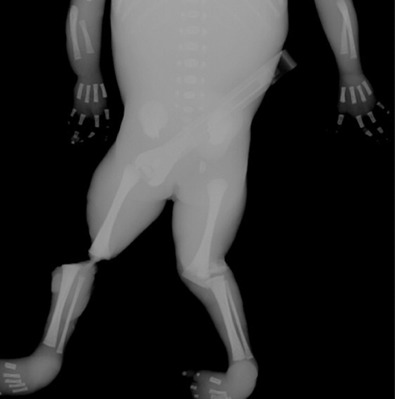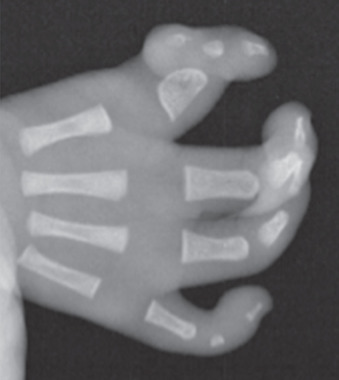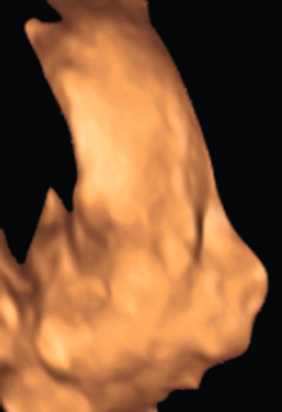Abstract
Facial dysotosis can be divided into two types: mandibulofacial dysostoses (MFDs) and acrofacial dysostoses (AFDs). MFDs typically have no limbs defects, while AFDs are associated with limb abnormalities. Treacher Collins syndrome (TCS) is the most common MFD, while Nager syndrome is the most common AFD. Prenatal ultrasound (US) can diagnose both MFDs and AFDs. US findings in Treacher Collins syndrome include micrognathia, transverse facial cleft, and low set ears. In Nager syndrome, US findings include severe mandibular hypoplasia and retrognathia (malformed ears, mesomelic shortening and limb abnormalities that include radial ray defects, and oligodactyly). Both upper and lower limbs can be affected.
Keywords
mandibulofacial dysostoses (MFDs), acrofacial dysostoses (AFDs), Treacher Collins syndrome, Nager syndrome
Introduction
Among newborns with birth defects, approximately one-third show craniofacial abnormalities, which cause significant morbidity and mortality. More than 700 distinct craniofacial syndromes have been described to date. Facial dysostoses can be divided into two types: mandibulofacial dysostoses (MFDs) and acrofacial dysostoses (AFDs). MFDs have typically no limb defects, while AFDs are associated with limb abnormalities. At least eight MFDs have been described, with the most common being Treacher Collins syndrome (TCS). AFDs are a genetically heterogeneous group of inherited disorders unified by craniofacial and limb abnormalities. At least 18 distinct types of AFDs have been characterized based on the specific patterns of limb abnormalities. They have been further classified into those with preaxial limb abnormalities, those with postaxial defects, and a subset that cannot be classified into either group. There is significant phenotypic overlap for these disorders.
Disorder
Definition
MFD disorders exhibit a profound effect on facial development and are considered facial dysostoses. AFDs show both facial and limb abnormalities, and are part of the continuum of facial dysostoses.
Prevalence and Epidemiology
The most common MFD is TCS, which occurs with an incidence of about 1 : 50,000 live births. TCS is inherited in an autosomal dominant manner in most cases; however, a rare recessive form has been described. Nager syndrome is the most common AFD and is extremely rare, with fewer than 100 cases reported in the literature.
Etiology, Pathophysiology, and Embryology
TCS results from heterozygous mutations in the gene encoding TCOF1 in the vast majority of cases. Heterozygosity for mutations in POLR1D can also lead to TCS, as can recessively inherited mutations in POLR1C . All three genes, either as binding partners or subunits of a complex, are involved in the RNA polymerase function and ribosomal biogenesis.
Nager syndrome and the allelic but more severe Rodriguez syndrome are autosomal dominant disorders that both result from heterozygosity for mutations in SF3B4 . In about 50% of cases of Nager syndrome, tested mutations have been identified in SF3B4 , suggesting that another gene is responsible for some of the cases. The SF3B4 gene encodes a spliceosomal protein that removes introns and ligates exons during RNA splicing.
Manifestations of Disease
Clinical Presentation
TCS is a congenital disorder of craniofacial development that exhibits reduced penetrance, with some very mildly affected individuals and some much more severe. Characteristic features of TCS include hypoplasia of the facial bones (particularly the maxilla, mandible, and zygoma) with orbital clefting producing a distinct facial appearance. The clefting causes downward slanting of the palpebral fissures with colobomas of the lower eyelids and absence of the medial third of the lower eyelashes. Abnormalities are commonly seen in the size, shape, and position of the ears. These external ear abnormalities are associated with atresia of the external auditory canals and anomalies of the middle ear ossicles, producing varying forms of deafness. The limbs are typically normal.
Nager syndrome is an acrofacial dysostosis that encompasses malformations of the facies and the limbs. Characteristic findings include midface hypoplasia, micrognathia, choanal atresia, cleft palate, and sensorineural hearing loss. Limb defects usually affect the radial elements of the forelimbs and include hypoplasia or agenesis of the radius, or radioulnar synostosis ( Fig. 58.1 ). In addition, hypoplasia or agenesis of the thumbs, or triphalangeal thumbs (three ossification centers) have been observed as part of the condition. Oligodactyly, phocomelia of the upper limbs, and occasionally lower-limb defects have also been reported in the more severe form of AFD, Rodriguez syndrome, which has been shown to be allelic and has even more severe limb abnormalities ( Fig. 58.2 ).


Imaging Technique and Findings
Ultrasound.
Prenatal ultrasound (US) has been used to diagnose numerous MFDs and AFDs. US findings in TCS include micrognathia, transverse facial cleft, and low-set ears ( Fig. 58.3 ), particularly if there are no other US findings and normal growth parameters. Polyhydramnios has been also described in some cases.











